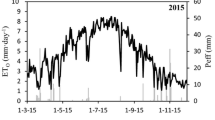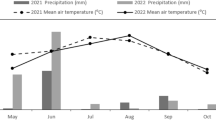Abstract
Potato production can be adversely affected by both deficient and excess water. A plant water excess (PWE) index is defined as the difference between actual evapotranspiration (AET), which is equal to the difference between rainfall and runoff, and potential evapotranspiration (PET), as computed by the Thornthwaite method, for those 5-day periods when AET exceeds PET. A growing season PWE index was equal to the accumulation of 5-day average PWE values and was calculated for each of 30 years of data. Similarly a plant water deficit (PWD) index was defined as the PET-AET for those 5-day periods when PET exceeds AET. Potato yields during the 30-year period were related to the combined effect of yearly water excess (PWE) and deficit (PWD) and can be described by the multiple regression relationship of Y = 43.558-0.74527 (PWD + PWE)+ 0.031883 (PWD × PWE). This model has a multiple r2 value that indicates 46% of the yield variation can be accounted for by the combined yearly influence of deficient and excess water. The results suggest that maximizing potato production in the humid Northeast requires a water management system that includes both supplemental irrigation and drainage.
Resumen
La productión de papa puede ser afectada adversamente tanto por la deficiencia como por el exceso de agua. Un índice del exceso de agua en la planta (PWE) se define como la diferencia entra la evapotranspiración real (AET), que es igual a la diferencia entre la precipitación y el escurrimiento, y la evapotranspiración potencial (PET), tal como se calcula por el método de Thornthwaite, para aquellos períodos de 5 días en que AET excede a PET. El índice PWE en una estación de crecimiento fue igual a la acumulación de valores promedios PWE de 5 dias y fue calculado para los datos de cada uno de los treinta años. De manera similar se definió un indice de deficiencia de agua de la planta (PWD) como PET-AET para aquellos períodos de 5 días en que PET excede AET. Los rendimientos de papa durante el periodo de 30 años fueron relacionados al efecto combinado de excesos anuales de agua (PWE) y de déficit (PWD) y puede describirse según una relación de regresión múltiple de Y = 43.558-0.74527 (PWD + PWE)+ 0.031883 (PWD×PWE). Este modelo tiene un valor r2 múltiple que indica que 46% de la variación del rendimiento puede atribuirse a la influencia anual combinada del agua en déficit y en exceso. Los resultados sugieron que para maximizar la producción de papa en al húmedo Nor-este se requiere un sistema de manejo de agua que incluya tanto riego suplementario como drenaje.
Similar content being viewed by others
Literature Cited
Benoit, G.R. and W.J. Grant. 1980. Plant water deficit effects on Aroostook County potato yields over 30 years. Am Potato J 47:585–594.
Bushnell, J. 1956. Growth response from restricting the oxygen at roots of young potato plants. Am Potato J 33:242–248.
Epstein, E. 1974. Variability of drought in the Northeast. Maine Life Sci Agric Exp Stn Tech Bull 69.
Fulton, J.M. and H.F. Murwin. 1955. The relationship between available soil moisture levels and potato yields. Can J Agric Sci 35:552–556.
Harkett, P.J. and W.G. Burton. 1975. The influence of a low oxygen tension on tuberization in the potato plant. Potato Res 18:314–319.
Holder, C.B. and J.W. Cary. 1984. Soil oxygen and moisture in relation to Russet Burbank potato yield and quality. Am Potato J 61:67–75.
Jacob, W.C., M.B. Russel, A. Klute, G. Levine and R. Grossman. 1952. The influence of irrigation on the yield and quality of potatoes on Long Island. Am Potato J 29:292–296.
Murphy, H.J., M.J. Goven and H. Plate. 1975. Effect of differential fertilizer rates and supplemental irrigation on yield, quality and chemical composition of Katahdin potatoes in Maine. Maine Life Sci Agric Exp Stn Bull 714.
Pullen, W.E. and W.E. Schrumpf. 1962. The economics of irrigating potatoes in Maine. 1956–1959. Maine Agric Exp Stn Bull 603.
Saini, G.R. 1976. Relationship between potato yield and oxygen diffusion rate of subsoil. Agron J 68:823–825.
Struchtemeyer, R.A., E. Epstein and W.J. Grant. 1963. Some effects of irrigation and soil compaction on potatoes. Am Potato J 40:266–270.
Thornthwaite, C.W. and J.R. Mather. 1957. Instructions and tables for computing potential evapotranspiration and the water balance. Drexel Institute of Technology Laboratory of Climatology. Publications in Climatology Vol. X, No. 13.
Author information
Authors and Affiliations
Additional information
Contribution from the New England Plant, Soil and Water Laboratory, Agricultural Research Service, USDA, and the Maine Agricultural Experiment Station, University of Maine, Orono, Maine 04469.
Rights and permissions
About this article
Cite this article
Benoit, G.R., Grant, W.J. Excess and deficient water stress effects on 30 years of Aroostook County potato yields. American Potato Journal 62, 49–55 (1985). https://doi.org/10.1007/BF02903462
Accepted:
Issue Date:
DOI: https://doi.org/10.1007/BF02903462




